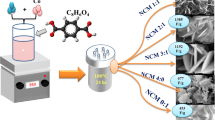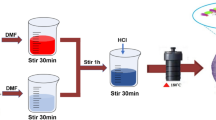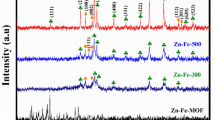Abstract
Metal–organic frameworks (MOFs) are promising materials for supercapacitors due to their surface area and tunable pore size. Pristine monometallic MOFs suffer from low conductivity. In this work, bimetallic Ni-rich/Co-MOFs were synthesized via a one-step solvothermal method. Various Ni2+ and Co2+ stoichiometric ratios were considered and their impact on MOF structure and electrochemical performance was evaluated. It was found that Co2+ substitution in the initial Ni-MOF structure enhanced the electrochemical properties, providing a specific capacitance of 1303 F g−1 (145 mAh g−1) at 1 A g−1, almost double than the monometallic Ni-MOF. An optimum stoichiometric ratio of (2)Ni:(1)Co was obtained.
Graphical abstract




Similar content being viewed by others
Data availability
The data that support the findings of this study are available from the corresponding authors, I.N and E.G, upon reasonable request.
References
A. Shahsavari, M. Akbari, Potential of solar energy in developing countries for reducing energy-related emissions. Renew. Sustain. Energy Rev. 90, 275–291 (2018)
H. Lund, Renewable energy strategies for sustainable development. Energy 32, 912–919 (2007)
E. Gkanas et al., Hydrogenation behavior in rectangular metal hydride tanks for green building applications. Energy 142, 518–530 (2018)
T. Mehtab et al., Metal-organic frameworks for energy storage devices: Batteries and supercapacitors. J. Energy Storage 21, 632–646 (2019)
F. Li, Z. Zhou, Micro/nanostructured materials for sodium ion batteries and capacitors. Small 14, 1702961 (2014)
J.R. Miller, A.F. Burke, Electrochemical capacitors: Challenges and opportunities for real-world applications. Electrochem. Soc. Interface 17(1), 53 (2008)
S. Chen et al., Recent advancements in electrode materials for high-performance electrochemical supercapacitors: a review. Int. J. Electrochem. Sci. 9, 4072–4085 (2014)
O.M. Yaghi et al., Selective binding and removal of guests in a microporous metal–organic framework. Nature 378, 703–706 (1995)
C. Duan et al., Recent advancements in metal–organic frameworks for green applications. Green Energy Environ. 6(1), 33–49 (2021)
V.V. Butova et al., Metal-organic frameworks: structure, properties, methods of synthesis and characterization. Russ. Chem. Rev. 85, 280 (2016)
J. Yang et al., Layered structural Co-based MOF with conductive network frames as a new supercapacitor electrode. Chem.-Eur. J. 23, 631–636 (2017)
P. Du et al., Fabrication of hierarchical porous nickel-based metal-organic framework as novel pseudo-capacitive material for asymmetric supercapacitor. J. Colloid Interface Sci. 518, 57–68 (2018)
Y. Jiao et al., Mixed-metallic MOF based electrode materials for high-performance hybrid supercapacitors. J. Mater. Chem. 5, 1094–1102 (2017)
M.R. Lukatskaya et al., Understanding the mechanism of high capacitance in conductive metal-organic frameworks in aqueous electrolytes. ACS Nano 14(11), 15919–15925 (2020)
R. Díaz et al., Co8-MOF-5 as electrode for supercapacitors. Mater. Lett. 68, 126–128 (2012)
X. Zhang et al., Nickel/cobalt bimetallic metal-organic frameworks ultrathin nanosheets with enhanced performance for supercapacitors. J. Alloys Compd. 825, 154069 (2020)
S. Gao et al., Dandelion-like nickel/cobalt metal-organic framework based electrode materials for high-performance supercapacitors. J. Colloid Interface Sci. 531, 83–90 (2018)
J. Wang et al., Rational construction of triangle-like nickel-cobalt bimetallic metal-organic framework nanosheets arrays as battery-type electrodes for hybrid supercapacitors. J. Colloid Interface Sci. 555, 42–52 (2019)
Y. Liang et al., Nickel cobalt bimetallic metal-organic frameworks with a layer-and-channel structure for high-performance supercapacitors. J. Energy Storage 33, 102149 (2021)
G. Sahoo et al., Ligand-controlled growth of different morphological bimetallic metal-organic frameworks for enhanced charge-storage performance and quasi-solid-state hybrid supercapacitors. ACS Appl. Mater. Interfaces 15, 21097–21111 (2023)
N. Raza et al., Recent advances in bimetallic metal-organic framework as a potential candidate for supercapacitor electrode material. Coord. Chem. Rev. 430, 213660 (2021)
Z. Lv et al., 3D flower-like hierarchical Ag@nickel-cobalt hydroxide microsphere with enhanced electrochemical properties. Electron. Mater. Lett. 12(6), 824–829 (2016)
M. Zong et al., Phosphorylated NiCo metal-organic frameworks for efficient oxygen evolution reaction. Int. J. Electrochem. Sci.Electrochem. Sci. 16, 5 (2021)
H. Wang et al., Advanced metal-organic frameworks for energy storage applications. Front. Energy 15, 682–697 (2021)
Y. Xu et al., A facile synthesis of hierarchical porous Cu3(BTC)2-based microspheres as an efficient electrocatalyst for the oxygen reduction reaction. J. Mater. Chem. A 4(43), 16800–16807 (2016)
F. Cheng et al., Co-based MOF nanosheets with multiple active sites for ultrahigh-rate supercapacitors. Chem. Commun. 55(24), 3494–3497 (2019)
H. Fei et al., Cation exchange in coordination polymers for direct encapsulation of cobalt complexes and application to oxygen catalysis. Angew. Chem. Int. Ed. 58(19), 6256–6260 (2019)
X. Yin et al., A new nickel-based metal-organic framework for enhanced energy storage. Mater. Lett. 275, 128044 (2020)
J. Wang et al., Rational construction of triangle-like nickel-cobalt bimetallic metal-organic framework nanosheets arrays as battery-type electrodes for hybrid supercapacitors. J. Colloid Interf. Sci. 555, 42–52 (2019)
Acknowledgments
The authors thank Chris Waldron for XPS data collection and interpretation, facilitated by the Seedcorn Access scheme which is part of the EPSRC-funded Warwick Analytical Science Centre (EP/V007688/1). Chiara Milanese acknowledges support from the Ministero dell’Università e della Ricerca (MUR) and the University of Pavia through the program “Dipartimenti di Eccellenza 2023–2027.”
Funding
This work is partially financially supported by the Lloyds Registered Foundation (ICON Schemes), Reference 515432241.
Author information
Authors and Affiliations
Contributions
IN carried out the MOFs syntheses, SEM, EDX, XRD, FTIR, BET, and electrochemical characterizations. IN performed data analysis and drafted the manuscript. RL participated in the electrochemical characterization and electrode preparation. CM carried out the TGA characterization. MW carried out the XPS characterization and analysis. SD participated in the electrochemical characterization and analysis. AR participated in the coordination of the electrochemical characterization, electrochemical analysis, and helped draft the manuscript. EG conceived the study, participated in its design and coordination, participated in MOF synthesis and electrochemical characterization, electrode preparation, data analysis, and helped to draft the manuscript.
Corresponding authors
Ethics declarations
Competing interest
The authors declare that they have no known competing financial interests or personal relationships that could have appeared to influence the work reported in this paper.
Additional information
Publisher's Note
Springer Nature remains neutral with regard to jurisdictional claims in published maps and institutional affiliations.
Supplementary Information
Below is the link to the electronic supplementary material.
Rights and permissions
Springer Nature or its licensor (e.g. a society or other partner) holds exclusive rights to this article under a publishing agreement with the author(s) or other rightsholder(s); author self-archiving of the accepted manuscript version of this article is solely governed by the terms of such publishing agreement and applicable law.
About this article
Cite this article
Ntoukas, I., Lan, R., Milanese, C. et al. Ni/Co bimetallic flower-like metal–organic frameworks with enhanced performance for high-power energy storage applications. MRS Communications 14, 69–75 (2024). https://doi.org/10.1557/s43579-023-00501-8
Received:
Accepted:
Published:
Issue Date:
DOI: https://doi.org/10.1557/s43579-023-00501-8




